-
As of today ICMag has his own Discord server. In this Discord server you can chat, talk with eachother, listen to music, share stories and pictures...and much more. Join now and let's grow together! Join ICMag Discord here! More details in this thread here: here.
You are using an out of date browser. It may not display this or other websites correctly.
You should upgrade or use an alternative browser.
You should upgrade or use an alternative browser.
uk clone only! (and british bred strains)
- Thread starter lovelightpower
- Start date
- Status
- Not open for further replies.
I'd say Verdant's is showing a little Thai influence too as the Oaxacan doesn't grow long foxtails like his has, but it may be down to grow style. I have seen Blueberry's similar to Verdant's out of the line I have, they were a little more sativa leaning than the one I keep I seem to recall.
The Oaxacan I have going now isn't foxtailing at all, possibly due to the blue and UV light it is bathed in. It's growing rather differently, but again, could be down to different grow styles.
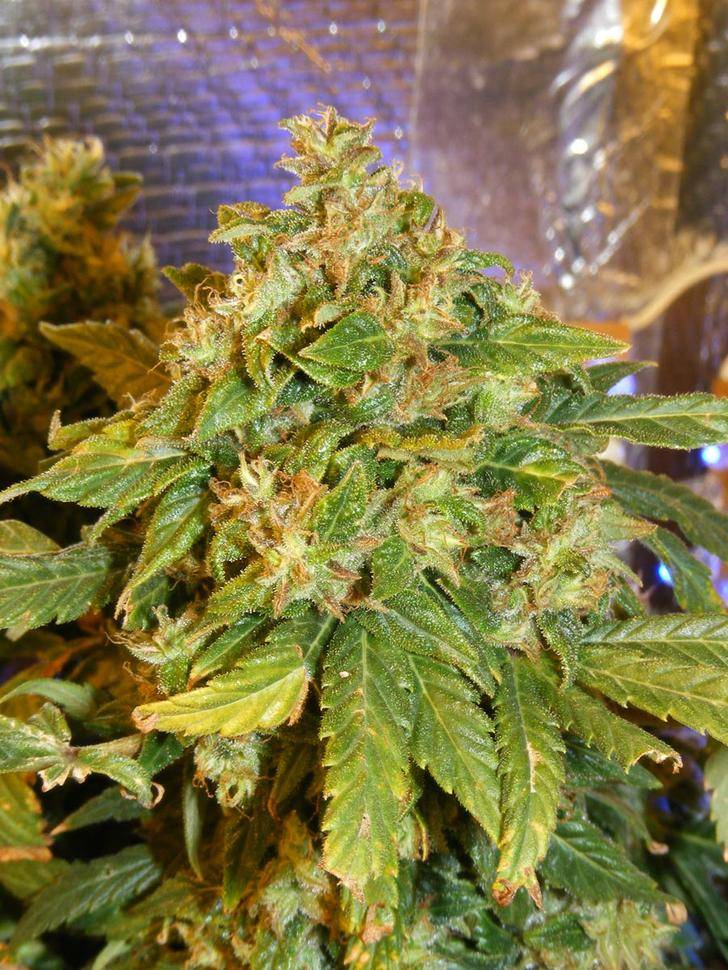
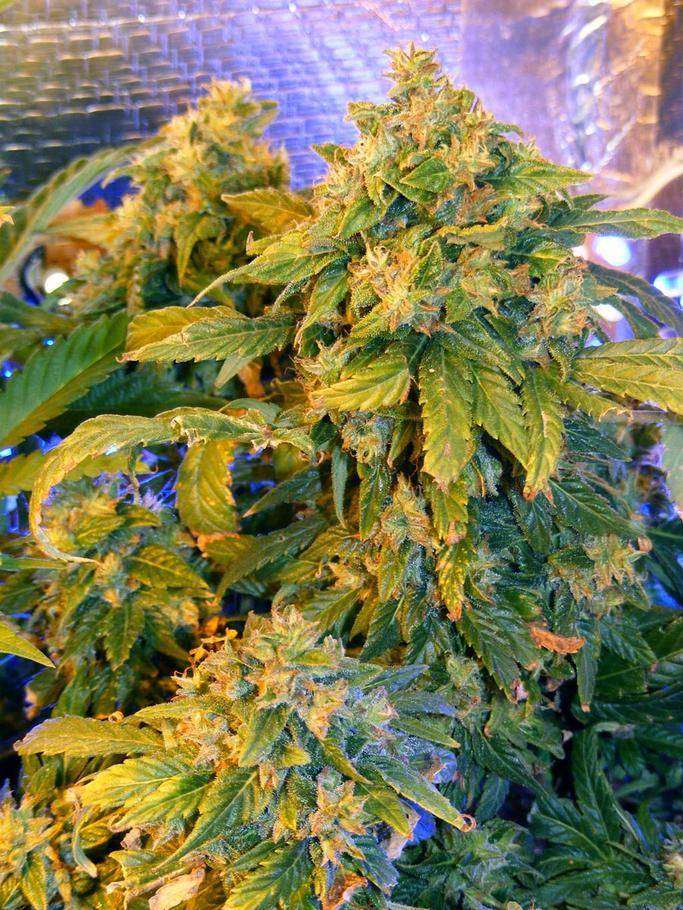
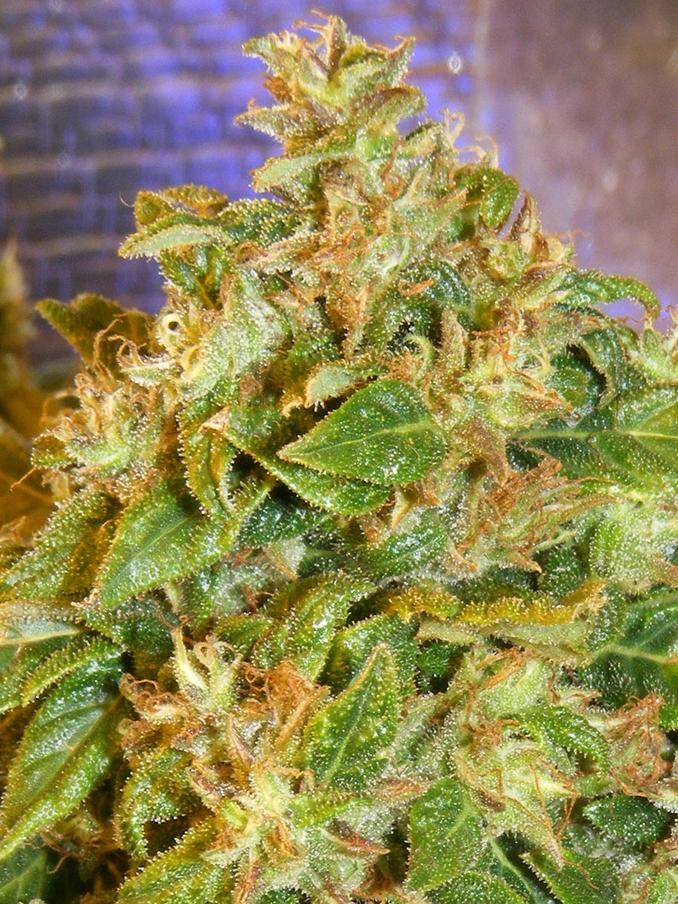
The Oaxacan I have going now isn't foxtailing at all, possibly due to the blue and UV light it is bathed in. It's growing rather differently, but again, could be down to different grow styles.
yeh man.......spot the difference!!!
H
hulkbogan
BeautifulHeres my blue sat clone, Had her some time now..
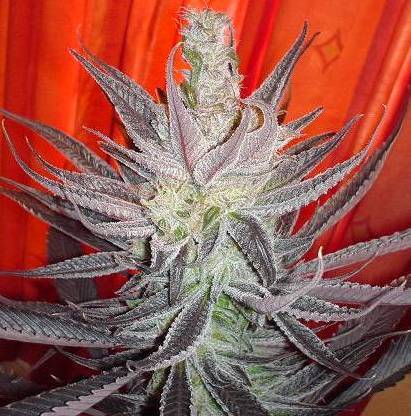
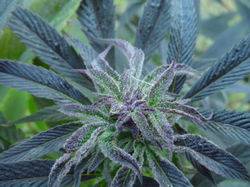
I just remembered why i kept the Purple Thai male I have (Thai x Purple Afghan) it was to pollinate the HOG! It's a bit late to pollinate this HOG as it will take a few weeks for the male to drop pollen if I put him into flower now. I'm rooting some HOG cuts so I'll have to get that cross done next round. I'm sure Dj would approve of me emulating his idea! lol
The Purple Thai does put out some lovely phenos though and the cross to the HOG should produce some interesting variation to select from.
Purple Thai pheno I did recently 12/12 from seed:
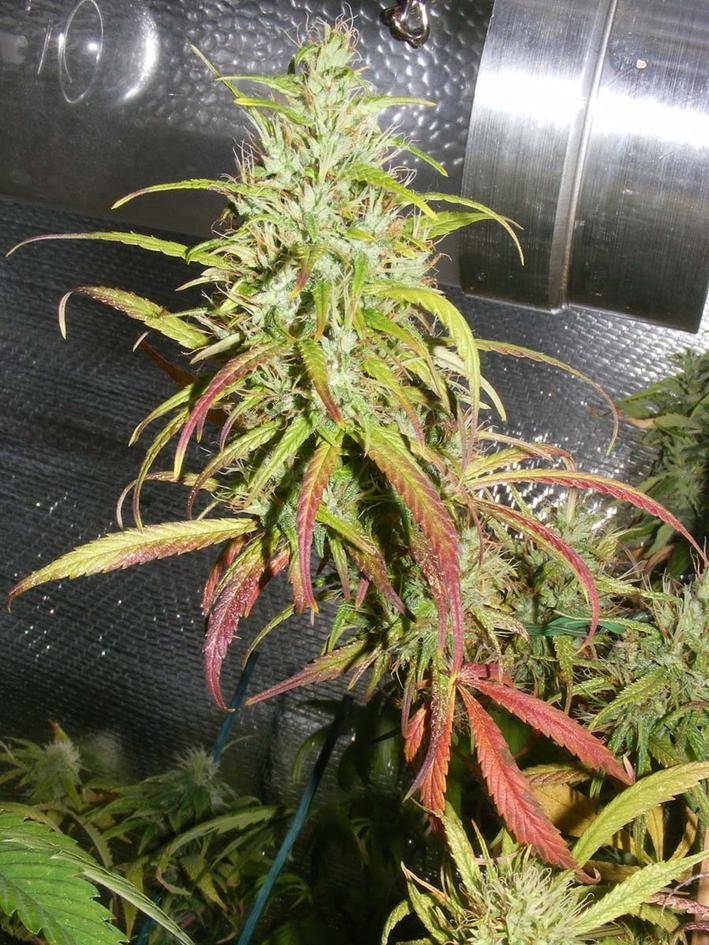
The Purple Thai does put out some lovely phenos though and the cross to the HOG should produce some interesting variation to select from.
Purple Thai pheno I did recently 12/12 from seed:
hay doc,,,,what did the FT do to the WW, ??,,,,,,im guessing solomon had a prized widow and hit it with a select freetibet male??
Nah man,, they grew out White Widow from two seperate breeders and the Free Tibet from Soma at the same time. The best females from both WW and FT were isolated ,, and the best males from FT and WW were isolated... then invidually married to their genetic oposites.
This gave x9 new hybrids to play with... after growing and smoking the samples #1-9 ,, one line of the WWxFT was released. So7omon Seeds still have the other x8 crosses including the Free Tibet x White Widow lines.

i was just talking with indiff about your experence with MNS spice,,,,,it looks prommising,,,,i bet spicy cheese F2 is cool
Spice is the best strain we've tasted from Shanti.
Spicy Cheese F2 was better than Spicy Cheese F1 ... more variety and flavour... more resin.
SpCh F2 was open-bred using several males and several females to help maintain genetic diversity.
im actualy supprized the uk dont have more old blueberrys clones from dj,,,
They hermed in most grow-rooms and the mothers soon became too played out and just wanted to flower... like Grapefruit.
Peace n flowers
They hermed in most grow-rooms and the mothers soon became too played out and just wanted to flower... like Grapefruit.
Peace n flowers
Thank Dutch Passion for fucking BB up really badly, full of hermies, freaks, mutants and runts. DJ's Blueberry had the odd one, but not many at all and there were plenty of solid females to chose from.
thats very cool doc ,,,,,,,,,,WW x FT [or] FT x WW must be pretty good then
,,,,,,,,,,WW x FT [or] FT x WW must be pretty good then  ,,,,,that level of testing is pretty impressive
,,,,,that level of testing is pretty impressive
did youguys not try DJ BB?,,,,,,,ive heard the same thing about DPashion,,,,it sounds like they f-up the BB
i remember now,,,,,,everyone complain about deformitys with BB,,,,it probbly was DP who exagerated the issue , none of my local friends have heard of DJ
played-out clones sounds like bad news.....i can understand why peeps didnt want it now,,,,,,,,it is a shame tho
did youguys not try DJ BB?,,,,,,,ive heard the same thing about DPashion,,,,it sounds like they f-up the BB
i remember now,,,,,,everyone complain about deformitys with BB,,,,it probbly was DP who exagerated the issue , none of my local friends have heard of DJ
played-out clones sounds like bad news.....i can understand why peeps didnt want it now,,,,,,,,it is a shame tho
J
jingles

Heres the BS mum, This pic was tacken in 08..J.
great stuff guys - i'm interested in all your takes on the BB line.
ill dredge up some more pics of mine soon. i agree about the thai influence.
V.
ill dredge up some more pics of mine soon. i agree about the thai influence.
V.
I thought this was worth posting here,,,,then i wont lose it
Guest said:I did a search to see if this and the other DJ articles had already been posted here, but I only found obscure links to other sites with the articles. If anyone knows that this or the other has already been posted in full on this site, please let me know. Now lets all bask in DJ's skills
DJ Short - The Origins of Blueberry
Choosing your parents
The place for breeding to begin is with choosing the parent plants, called the P1 generation. For best breeding results you use true-breeding stabilized strains as your P1's. Different breeders have different standards as to what qualifies as a P1. I have very high standards for my P1 generation. For me, the P1 must be either a fully acclimated, region-of-origin land-race variety, or no more than one generation removed, and crossed with itself or another highly similar, region-of-origin land-race variety.
I used three P1 strains to breed Blueberry, Flo and others. They were the Highland Thai (also called Juicy Fruit Thai, a first-generation Thai seed grown in the Pacific Northwest); a cross called Purple Thai which was a first generation land-race Chocolate Thai crossed once with a first generation land-race Highland Oaxaca Gold; and an Afghani Indica which came to me one generation removed from Afghanistan via the California/Southern Oregon growing community.

Juicy Fruit
The Highland Thai was a joy to grow and behold, despite its hermaphroditism. This plant grew fast, filling in any empty spaces with lush, green growth. It was a very slow finisher, 12 to 16 weeks and beyond in the bud period for most. It had the longest and skinniest leaves out of all the plants I have worked with. Thick side-branching is another characteristic of this variety.
The plant only periodically produced any kind of "tight" bud structure. Most of the buds were very loose, with some sporting long, slender shoots of widely-spaced single female flowers in a row (especially when grown hydroponically under halide lights.)
This bud structure is known as "spindly". Many of these spindles resemble threads protruding from a semi-formed bud. Each single thread averaged anywhere from five to ten inches long, some even longer, and consisted of a row of evenly-spaced female flowers and their corresponding bract leaves, anywhere from a quarter inch to one inch apart, alternating bract and flower in single file.

Thai
The entirety of the "thread" and bud structure was coated with sweet/fruity aromatic resin glands.
The overall plant color was dark, while the bud structures matured a lighter shade of green, sometimes green/yellow.
I was never able to get a Juicy Fruit Highland Thai to "over mature". I took one to almost twenty weeks into its flower cycle and she just kept pumping it out. Outdoors, one was taken in early-mid December from a greenhouse. The only difference was that the later harvest was a more stony, body high.
The finished product from the Highland Thai was an all-around champion herb. Though difficult to trim and cure, the outcome was fully worth the effort. It was a powerful, long-lasting and exquisitely flavoured herb with little or no ceiling. The high could last up to seven hours! The flavour, aroma and taste were a totally sweet tropical punch – tutti-fruity all the way.
The Purple Thai was the other sativa in my repertoire. This was a first generation cross between the Highland Oaxaca Gold and the Chocolate Thai. This cross grew medium/tall and was very symmetric in structure. The side branches were shorter and, if left alone (untopped) the main stalk (meristem) remained the dominant shoot.

Afghani
The entire plant of the Purple Thai was very dark-coloured and would express a deep royal purple colour at the slightest exposure to cold. It did not exhibit any of the spindly bud syndrome of the Juicy Fruit Thai, and the finished buds were a medium and compact sativa type. The finished product was equally as fruity and strong as the Juicy Fruit, also without ceiling.
For whatever aesthetic reason, I preferred the Purple Thai to the Juicy Fruit Highland Thai. I believe that the Purple Thai was emotionally kinder or gentler than the Juicy Fruit. At larger doses the Juicy Fruit could evoke quite a terror, especially when combined with psychedelics. Though no less potent, the Purple Thai seemed easier to handle, including when tripping. The Purple Thai was one of the first to show resin gland production in the early bud cycle, at roughly three to four weeks into the cycle. It also matured at 10 to 12 weeks indoor, and early to mid November outdoors.
The Afghani Indica plant is short with large, wide leaves, stout and thick-stemmed. It has early to very early maturation, producing large, dense buds that smell earthen to skunk, with a strong smoke that is generally sedative or "down" in effect. Though consistent in its growth and overall effect, its appeal is somewhat limited in my opinion. I believe more indicas should be made into hashish, which is where the finer qualities of the indica appear.

Blueberry x Afghani
The sinsemilla Afghani Indica first showed up on the market in 1979. They were huge, green, stinky, sticky, dense buds of potent, pungent herb that smelled like a skunk and produced a narcotic-knockout stone that was tremendously novel, when compared to all the sativas that had come before. This was right after sinsemilla herb hit the market with big appeal.
The triad of sinsemilla, indica, and the advent of high powered halide and HPS lights, all wreaked havoc on the breeding programs of most pot-entrepeneurs. Few people maintained their sativa lines, and the strains virtually disappeared from the commercial markets. The short, dense, early-maturing and body-powerful indica has dominated the scene since 1983 – a matter of disjointed economics.
Such were the three main P1's I used for my breeding lines.

Afghani male
The f1 cross
The f1 cross is the first cross between two distinctly different P1 parents. The "f" stands for filial (child). I cannot overstress the importance of the two P1 parents being as genetically different as is possible. It is this initial genetic diversity that leads to the most possibilities in succeeding lines.
If the P1's are sufficiently diverse, then the f1 will be a true hybrid, expressing a near total uniformity and great vigor. It is in the crosses beyond the initial f1 (especially the f1xf1=f2 cross) that specific traits are sought. There will be a tremendous amount of variance in the f2 crosses of f1's obtained from a female pure sativa and a male pure indica.
The Blueberry (among others) was discovered and stabilized from an f1 cross between the P1 parents of a female Juicy Fruit Thai or a female Purple Thai and a male Afghani Indica. Thus there were two possible routes to essentially the same finished product. Blue Velvet and Flo seem more accessible via the Purple Thai route, while Blue Moonshine seems more accessible through the Juicy Fruit lineage. That is, there is a higher probability of occurence of the specific traits which I'm seeking, and so they're easier to "find".
Oddly enough, the opposite cross (female Afghani indica crossed with pollen from male Thai sativa) was not nearly as interesting. The f1's from this cross were more leafy and less desirable. They were also more hermaphroditic and subsequent breeding revealed them to be less desirable. It has been my observation that in a successful cross, the (usually female) sativa contributes the type of aroma and flavour, while the (usually male) indica contributes the amount of aroma and flavour to the prodigy. So far this observation has proven fruitful.

Blue Moonshine
So the Thai female is pollinated with the Afghani male and an abundance of seed is produced. The seed is uniformly sized and shaped; small, ellipsoid and mottled with dark stripes upon a grayish brown shell. A single female is capable of producing thousands of seed, leaving plenty for experimentation. This is the f1 generation, which I called simply "The Cross".
The plants of The Cross grew uniform, medium-tall "spear" structures of many competing side-branches around one main (meristem) stalk. Large, long buds formed along the branches. There was a wide palate of colours, especially among the Purple Thai cross. The buds were lighter, almost yellow to the centres, wile the outer leaf, bract and calyx tips showed red, purple and blue hues. The maturation rates were uniform as well, with a wide window of harvest being between weeks eight to eleven in the bud cycle, indoors. The finished bud had a very strong "astringent" chemical/terpene aroma that bordered between pine, gin, licorice and paint. Only a very few of The Cross expressed hermaphroditism, about 1 out of every 25 females.

Afghani
The f2 cross
The f2 is the second filial generation, simply a cross between any two of the f1 stock. With my f2 crosses the outcome was extreme, with almost every characteristic of the cannabis plant being expressed in some of the plants. The diversity was spectacular, both in structure and aesthetics. From sativa to indica, short to tall, dark to light, early to late maturation, wide to narrow leaves, along with an extensive array of flavours, aromas, tastes and highs. The f2 seeds collected were equally diverse, ranging from large to small, plump to slender, striped to solid, round to oval.
A grand amount of time, energy and money was spent from this point to isolate and stabilize the desired traits. There is a tremendous amount of work between the f2's and the f4's and f5's. Trial and error is the rule; certain paths prove futile while others bear further examination. On average, there are about nine errors to each success. Coupled with the difficult clandestine aspects of the trade through the 80's and 90's, it was a difficult task to accomplish. Many sacrifices were endured by my family and friends.
It was however, a fun and worthwhile occupation to sample all the research material. It was hard work and dedication to record the findings and attempt to create useful categories and find patterns and traits to specific characteristics. Then there's the wait for the cured sample. If the sample passed "the test" then the plant was kept for further consideration. The most desirable samples were used for further breeding to f3, f4 and f5. The harvested plants, cut above the lowest few nodes, were placed under a vegetative light cycle to stimulate new growth for cloning.

Blueberry x NL#5
I like to do one backcross somewhere between the f3 and f5 generation. Exactly when, where and how that is done remains a trade secret for now. Another trade secret is the art of selecting the best males for breeding. These topics and others will be covered in future articles.
Have phun!
Select the best, reject all others
Mendelian procedures are fine for sweet peas, but when it comes to herb I much prefer Luther Burbank's philosophy: "Select the best and reject all others!" This simple phrase is worth much consideration. Mendel's work is useful, especially concerning P1 and f1 crosses. But beyond the f2 and f3 cross, Mendel's theories add copius complexity to the equation.

Afghani clones
Your friend the freezer
A benevolent tool in our trade is the refrigerator and freezer. The fridge is extremely useful in extending the longevity of seed and pollen. The trick to successful freezing is to freeze deep (-10 to -40°F/-20 to -35°C) and then keep the seed undisturbed. Hard frozen objects are very fragile. The slightest shock may shatter crucial, delicate cell structures within the seed. Double wrap the seed in paper; little manilla envelopes work great.
I like to do small amounts, in one-time-use packets, to keep waste to a minimum. Then place the wrap into a plastic freezer bag, then place the freezer bag into a plastic tub or tupperware container. Now the seed is ready for the deep-freeze. In the fridge, storing seed in airtight, brown glass jars with a little rice or other non-toxic desiccant seems to work best.
I have had pollen last for years in a deep freeze. It must be frozen immediately after fresh collection from the plant, in as low a humidity as possible (preferably 0%). I like to shake the productive male flowers over a flat and clean piece of glass. The pollen pile is sifted to rid the unwanted plant material from the pure powder.
It is also useful to cut pollen with flour to stretch the amount. A pollen-to-flour ratio of 1:10 or even 1:100 works best. The cut pollen may then be separated into small, one-time-use amounts, stored in a flap of paper and frozen the same way as the seed. The frozen pollen must be applied to the live female flower immediately after thawing to increase viability.

Blue Velvet
The sweet sativa room
I recommend the creation of a special "sativa room" for indoor breeding of such strains. This room needs to consider and satisfy the unique needs of the sativa variety. The goal is to replicate the equatorial conditions of the world’s various "sweet spots". Some of these conditions include: a different light cycle than the standard 18/6 vegetative 12/12 bud cycles, a higher angle of light (using a straight track shuttle instead of a circular one), humidity control set on low for the highland and high for the lowland, and variations in soil composition and depth.
Light cycle is one of the key considerations for those wishing to breed truly fine quality cannabis indoors under lights. The 18/6 veggie and 12/12 bud cycles are perhaps the main influence towards the indica dominant strains and generic blandness of the indoor commercial product. A true equatorial sativa will require closer to a 13/11 vegetative and a long (four to six month) 11/13 flower cycle. Different variations may be tried, such as 15/9 veggie and 10/14 flowering cycle. Be prepared for much fine tuning.
Equatorial strains also experience a higher arch of sunlight than those grown beyond 38° north or south – with a sunrise almost due east and sunset nearly due west. Therefore the sativa room will edintense overhead lighting with a straight track mover. Keeping the plant in a stationary position, especially through the bud cycle, may positively influence the outcome of the finished product.
As jungle (lowland) herb requires only a thin layer of nutrient soil, perhaps a four-to-eight inch layer of soil over clay or concrete (with some form of drain system) would encourage lateral root growth, stationary plants, and a more lowland sativa-friendly environment.
If successful, the sativa-friendly room can be used to acclimate an indoor sativa variety, which expands the possibilities of your breeding operation.
guerilla
R
REDEYE_420
WOW cant wait to start reading through this thread!
Peace.
Peace.
Good comparison there.
Dime Bar (daime) anyone? Perhaps crushed over ice cream?
Dime Bar (daime) anyone? Perhaps crushed over ice cream?
daddy fingaz
Active member
Nice one for posting that rick, Dj's BB is such a pleasant high, always impresses me, id love to sample Verdantgreen's cut!!
V was it gifted to you or one you selected yourself!?
V was it gifted to you or one you selected yourself!?
is cool man,,,
Nice one for posting that rick, Dj's BB is such a pleasant high, always impresses me, id love to sample Verdantgreen's cut!!
V was it gifted to you or one you selected yourself!?
he he df!, my Blueberry was from a single feminised DP seed i grew out a couple of summers ago in my greenhouse. its kind of the reason why i started growing indoors again because i thought i had to keep it. - it went pretty colours outside but still wasnt properly finished in early nov. when i chopped it - got 8 oz and i only planted the seed in june!
so i took some reveg cuttings and built myself a cab in the loft.
this is the pic that i usually post - at 10 weeks
here is the same bud after 12!
and dried
after posting in the DJ short forum i was told that excess N and P were making it foxtail so the recent run i did was with less, and basically it has been pretty hungry all the way through yet to me the structure looks the same just not as big
smoke-wise the my Bb has that clear, slightly visually high that i associate with thai, it has a bit of stone too. its not what i smoke everyday but it has some great qualities. it basically gives you many of the 'medicinal' qualities of weed - relaxing and euphoric, uplifting - but without any dis-orientation or general stoned fuck-wittedness
Its what i would pick every time for a daytime smoke when i still need to be on the ball, or if i have family / non-smokers visiting. no-one can tell you are wasted but you still feel great.
all in all a fantastic strain.
would love to hear more about your Bb line indifferent - ive been looking for some good Bb pollen for a while now to tickle mine up with. even though it is feminised it is very stable. i only once saw a couple of nanners in the buds in very late flower but no seeds - and given Bb is very prone to nanners anyway i doubt with those genetics you would ever get a 'true' female like cheese is.
so apologies to all the fem-dodgers
V.
Well, my BB line is fan-fuckin-tastic, never seen a bad plant out of the line and the male i selected had shitloads of visible resin and made great outcrosses.
The remaining F2 seeds were planted earlier this year and didn't germ. I have a very few F3s left, tried germing 3, they popped, planted them and only 1 has come up. Elevator man has a few F3s, so there is still a chance of resurrecting it. I originally made 2500 of the F3s and spread em far and wide back in early 2007. 3 years later seems they have disappeared into people's stashes and no-one is owning up to having some!
There is one living plant from the F3s apart from my seedling, and that's an orangey chunky indica mamma Elevator man has in his stable.
Any further keepers that i find will get passed about and I will be doing my best to find a male and female to make F4s, it really is work preserving.
The remaining F2 seeds were planted earlier this year and didn't germ. I have a very few F3s left, tried germing 3, they popped, planted them and only 1 has come up. Elevator man has a few F3s, so there is still a chance of resurrecting it. I originally made 2500 of the F3s and spread em far and wide back in early 2007. 3 years later seems they have disappeared into people's stashes and no-one is owning up to having some!
There is one living plant from the F3s apart from my seedling, and that's an orangey chunky indica mamma Elevator man has in his stable.
Any further keepers that i find will get passed about and I will be doing my best to find a male and female to make F4s, it really is work preserving.
C
cork144

Heres the BS mum, This pic was tacken in 08..J.
oh my lord what a trunk
yeh man,,,it would be amazing to hold a propper BB line myself ,,,,,,,id love to work from the older stock too,,,,,ive got a feelin the current BBDJ stock is not the same as it used to be,,,,,,,,,,,,
,,,,,,,id love to work from the older stock too,,,,,ive got a feelin the current BBDJ stock is not the same as it used to be,,,,,,,,,,,,
its sounds like a Very Verygood incross/ anlmost pureline,,,,
anyone tried the TrueBlueberry?????
whats happening with the Rosebud??,,,,,,is it supposed to taste like Roses ???
???
its sounds like a Very Verygood incross/ anlmost pureline,,,,
anyone tried the TrueBlueberry?????
whats happening with the Rosebud??,,,,,,is it supposed to taste like Roses
- Status
- Not open for further replies.



